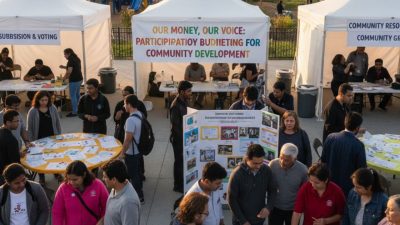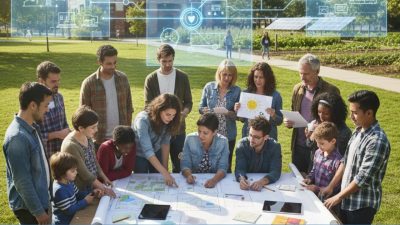Across cities and towns worldwide, communities are stepping out of the sidelines and into the driver’s seat of neighborhood transformation. Gone are the days when urban designers worked in isolation, delivering top-down schemes that often missed local needs. Today, community-led urban design empowers residents, planners, and stakeholders to co-create environments that reflect their collective vision and values. This collaborative approach fosters a sense of ownership, enhances social cohesion, and leads to more resilient and vibrant public spaces.
What Is Community-Led Urban Design?
Community-led urban design describes a process in which neighborhood residents, grassroots organizations, local businesses, and planning professionals partner throughout every stage of design and implementation. Instead of a consultant designing alone, the community contributes ideas, provides feedback on prototypes, and even participates in construction or maintenance. The result is not only a physically improved area but also a strengthened social fabric and increased trust between citizens and authorities.
Key Benefits
- Local ownership: When residents shape the outcome, they are more likely to protect and maintain it for the long term.
- Social capital: Collaborative design breaks down silos, forging connections among neighbors who might never have met.
- Contextual relevance: Solutions emerge from lived experience, ensuring better fit with cultural, economic, and environmental realities.
- Greater equity: Deliberate outreach elevates voices from underrepresented groups, balancing benefits across demographics.
- Flexibility: Iterative feedback loops enable rapid adjustments when unexpected issues arise.
Core Principles for Success

To harness these benefits, follow five guiding principles:
- Early Engagement: Invite diverse stakeholders from project inception, not after key decisions are made.
- Transparency: Share budgets, timelines, and constraints openly to build trust.
- Inclusivity: Use multiple outreach channels—online surveys, door-to-door visits, pop-up workshops—to reach seniors, youth, renters, and non-English speakers.
- Iterative Design: Prototype in phases—mockups, digital renders, small-scale pilot installations—then refine based on community feedback.
- Capacity Building: Invest in training residents on design fundamentals, facilitation skills, and project management, enabling them to lead future initiatives.
Tools and Methods
A range of techniques makes community-led design practical and engaging:
- Design Charrettes: Multi-day workshops where small teams rotate through stations to brainstorm, sketch, and vote on concepts.
- Community Mapping: Residents map assets, challenges, and desired improvements on printed or digital maps.
- Pop-Up Interventions: Temporary placemaking—parklets, street murals, guerrilla gardens—to test ideas in real time.
- Online Platforms: Interactive websites or apps where users annotate plans, leave comments, and view 3D models.
- Mobile Workshops: On-the-move engagement—walking tours, bike tours, mobile design labs—that meet people where they live.
A Step-by-Step Roadmap

Follow these stages to guide your community through a structured yet flexible process:
- Scoping: Define goals, budget, timeline, and key stakeholders. Conduct a baseline survey of physical assets and social networks.
- Engagement Plan: Craft a strategy for in-person and digital outreach. Set measurable targets for participation and demographic representation.
- Ideation: Host charrettes, mapping exercises, and informal meet-ups to generate concepts. Document all ideas, even those that seem impractical—they may spark other innovations.
- Prototyping: Select top ideas for low-fidelity testing. Use cardboard models, chalk, or digital renders to illustrate form and function.
- Refinement: Collect feedback via surveys and pop-ups. Iterate designs until consensus emerges on core elements.
- Implementation: Mobilize funding, permits, and volunteers. Schedule construction during windows that minimize disruption.
- Activation: Launch with a community festival, workshops, or storytelling events to celebrate the new space and honor contributors.
- Evaluation: Measure success against KPIs—use counts, survey responses, maintenance logs—and share results transparently.
Overcoming Common Challenges
Even the best-intentioned projects can face hurdles. Here’s how to address them:
- Resource Constraints: Leverage partnerships with local businesses, universities, or nonprofits to secure in-kind donations, volunteers, and pro bono services.
- Conflicting Opinions: Use design ballots or dot-voting to quantify preferences and move decisions forward democratically.
- Technical Complexity: Break projects into manageable phases. Build simple prototypes first, then scale up.
- Maintaining Momentum: Appoint community stewards to oversee upkeep and plan regular events that keep the space active.
Real-World Examples
Barcelona’s Superblocks transformed city grids by restricting traffic in clusters of blocks, opening streets for play and commerce. Local councils collaborated with residents through workshops and digital platforms to redefine public space. Today, superblocks contribute to reduced air pollution, safer streets, and thriving micro-economies.
Detroit’s Green Alley Project turned neglected backstreets into rain-absorbing, community-managed green corridors. Neighbors planted native vegetation, installed permeable paving, and organized maintenance days. The result: improved stormwater management and stronger neighborhood bonds.
Measuring Impact
Quantify your project’s success with metrics such as:
- Participation Rates: Number of unique participants in workshops, surveys, and events.
- User Satisfaction: Survey scores on perceived safety, comfort, and sense of belonging.
- Foot Traffic: Counts are taken before and after activation, using either manual tallies or sensor data.
- Maintenance Records: Frequency of repairs or volunteer clean-ups as an indicator of pride of place.
- Economic Indicators: Changes in local business revenues, property values, or new storefront openings.
Looking Ahead: Future Trends
Community-led urban design is evolving with technology and new social models:
- Digital Twins: Interactive 3D simulations that allow residents to explore design scenarios before construction.
- Augmented Reality: Mobile apps that overlay proposed streetscape changes onto real-world views.
- Participatory Budgeting: Online voting on funding allocations to empower residents with direct financial decisions.
- Temporary Urbanism: Rapid deployment of pop-ups and modular elements that adapt seasonally.
Conclusion
By putting people at the center of design, we can build stronger, happier, and more connected neighborhoods. Community-Driven Urban Design is not just about parks or streets—it’s about shaping spaces where everyone feels they belong. Whether it’s a small public garden, a local market, or a full neighborhood plan, collaboration turns ideas into reality. When residents, planners, and local governments work together, cities become more inclusive, sustainable, and vibrant.
Now is the time to bring your community’s vision to life. Invite your neighbors, share ideas, and co-create spaces that reflect your shared values. Together, we can transform everyday places into thriving, people-powered environments.





